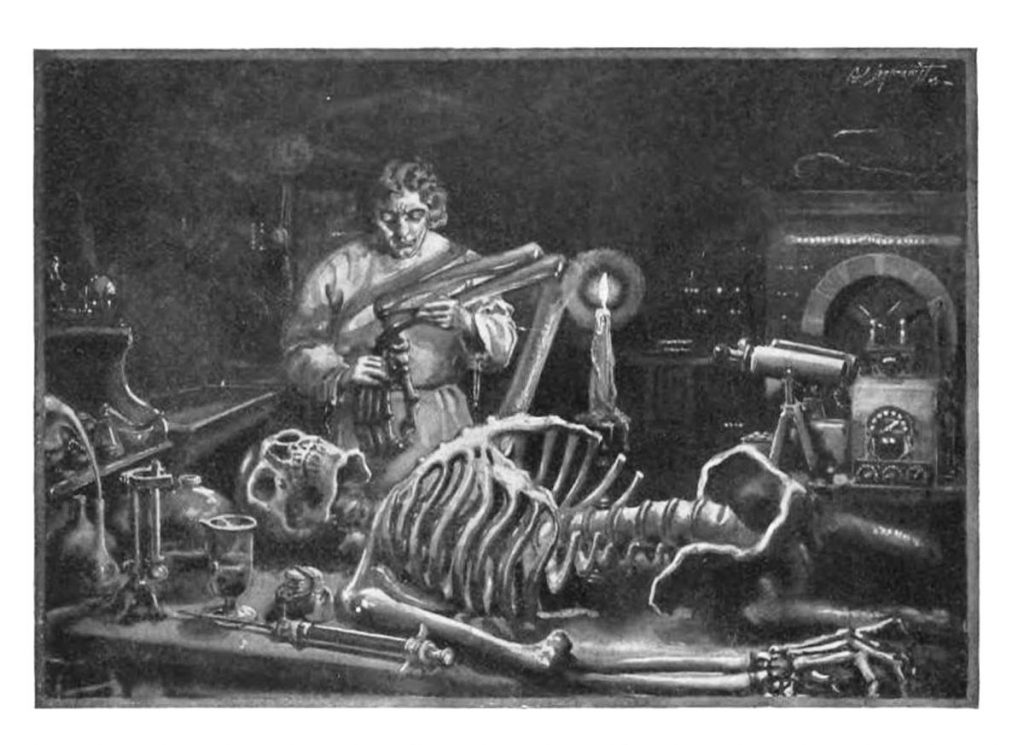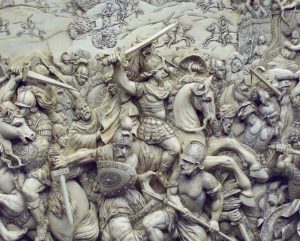Two hundred years after Frankenstein’s release, scholars and casual readers alike continue to study Mary Shelley’s most prominent work. On the surface, Frankenstein is simple horror: a gruesome monster turns against the scientist who created him and attacks his creator’s loved ones. One could argue that Shelley intended to warn readers against hubris, and that pushing outside the natural boundaries of science has consequences. However, a closer examination of the text reveals a social commentary in addition to the scientific one. Rather than begin Victor Frankenstein’s tale with his creation of the Monster, Shelley introduces the scientist as a dying man.1 The ailing scientist first reflects back on the events of his early years: his mother’s death and time spent with Elizabeth, a childhood companion who Victor later marries. As the story progresses, Shelley depicts not just the aftermath of the Monster’s attacks, but his interactions with Victor that precede the violence. When taken together, these moments weave a cautionary tale deeper than the apparent scientific warnings. In Victor’s treatment of the Monster, as well as the text’s depiction of women, Shelley paints a world in which the privileged class handles the outsider with disdain, and, in doing so, faces dire consequences.
To fully grasp Shelley’s intent in Victor’s treatment of the Monster, the reader must first consider who Victor is before he brings the Monster to life. In the first seconds of his tale, Victor states that his “family is one of the most distinguished” in Geneva.2 Even when he moves away to school, the young man has a “servant” available to wait on him.3 Furthermore, by pursuing education, Victor seeks “to join the new class of learned men” who “replaced the landed gentry as the upper society in Europe.”4 Through both heredity and action, Victor manifests the privileged class. Of course, the Monster does commit atrocities throughout Frankenstein, but not in his first living moments; if the Monster were inherently evil, he would have killed Victor when he was first brought to life. Therefore, any interaction between the two should not be viewed as man versus creature, but rather as a privileged being versus an outsider.With this context in mind, Victor’s treatment of his creation is clearly problematic. In perhaps the text’s most gripping moment, Victor marvels at the Monster as “the shriveled complexion and straight black lips” come alive. “Beautiful!” Victor exclaims.5 He dwells on every aspect of the Monster’s appearance, amazed at his own handiwork until he sours at the “horrid contrast” between the Monster’s “teeth” and “watery eyes.”6 In this scene, Victor never considers that he has somehow usurped the natural order or even that the Monster might turn out to be evil. He simply dotes on the physical appearance of his creation. So, when Victor “rushe[s] out of the room,” it is because he is disgusted by the pure physicality of the Monster, and not because of some terrifying moral epiphany.7

Aside from Victor’s initial fright—which would be understandable were he not the Monster’s creator—his aversion to his own creation never improves. Following the murder of Victor’s younger brother, William, Victor returns home to Geneva and eventually travels to Mont Blanc. As Victor navigates “the field of ice” at the mountain’s base, the monster appears, confronts Victor, and convinces his creator to follow him into a hut.8 Here, Victor asserts that he now understands “the duties of a creator towards his creation,” and this statement might seem true, considering Victor finally speaks with and listens to the creature.9 However, one must also consider that the Monster is both physically more powerful than Victor and Victor believes the Monster has murdered young William, suggesting that Victor never really has a choice in accompanying his creation. Once inside the hut, the Monster details his failed encounters with humans since he last saw his maker, and finally begs Victor to create a second life so that he may have a companion. Victor initially complies, believing that with a mate, the two creatures may find solace together away from Europe.10 While conflicted about bringing a second life into the world, Victor only rips apart the lifeless body of this creation when he sees his first creature staring in through the laboratory window.11 In this series of interactions between the young scientist and his creation, Victor is always motivated by the Monster’s appearance rather than by his actions.
In addition to the major plot events involving Victor, Shelley uses two subtle moments to comment on the Monster’s place in society. Scholar Anne Mellor explains, “only two characters…do not immediately interpret the creature as evil.”12 The blind Father De Lacey, who the monster tells Victor he encountered during his travels, cannot evaluate the Monster’s appearance. And the ship captain, Walton, who finds the dying Victor at the story’s very beginning, hears Victor’s description of the Monster before meeting him. Both men treat the creature with kindness.13 While neither of these characters advances the main narrative forward in the manner Victor does, they both depict a humane response to the creature, and, in doing so, highlight Victor’s cruelty towards his own creation. Unlike Father De Lacey and Walton who come away from their encounters with the Monster unscathed, Victor faces extreme consequences for abusing his creation. Indeed, Victor’s family is both literally and figuratively torn apart by the Monster. And, upon finally deciding to rid the world of his creation, Victor chases the Monster into the Arctic, where he is consumed by the hostile elements and eventually “sinks…into apparent lifelessness.”14 In essence, Victor manifests privilege; he is born into an influential household and receives opportunities others cannot. Contrarily, Victor’s creation is jerked into a hostile world where he is judged entirely by his appearance. Victor’s treatment of his creation—the outsider—is motivated entirely by the superficial trappings of physical appearance, a trap that ends in disaster for Victor and thereby the upper class he represents.

Underneath the plot’s surface lies a less obvious but equally important commentary on how humans treat one another. “Frankenstein,” authors Dorothy and Thomas Hoobler assert, “is a novel of male voices.”15 Indeed, this novel relies on three different narrators—all of whom are male—and focuses almost entirely on male characters. As “many Gothic novels…written by women” feature a “heroine rather than a hero,” the reader must examine why Mary Shelley would relegate women in Frankenstein to the background.16 Two sections in this novel should be of particular interest to the reader. First, as a child, Victor does express interest in science, but he does not progress from reading to experimentation until later; immediately after his mother dies, he departs for the “all-male world of the university.”17 Once at Ingolstadt, isolated “from the feminine” influence that defined his childhood, Victor falls into the dark world of pushing outside science’s moral boundaries.18 Secondly, while Victor loves Elizabeth enough to marry her, she remains absent for most of the text, providing almost no value to the narrative until the end. Once the Monster kills Elizabeth, Victor finally resolves to destroy his creation. Therefore, Elizabeth’s only significant contribution to the text is as a passive recipient of another character’s action.

While one could argue that the lack of female representation in Frankenstein constitutes nothing more than Shelley’s desire to highlight the struggle between Victor and his creation, this argument fails to examine Shelley’s other options as an author as well as the context in which the book was written. Were Shelley only concerned with the scientific aspects of Frankenstein, she would have begun Victor’s narrative in a far more interesting place than his childhood, perhaps in the morgue searching for limbs to fuse together. Furthermore, the Monster’s first murder could have just as easily provoked Victor to action. These alternatives delineate that Shelley’s choice to include Victor’s mother and Elizabeth’s murder in the narrative was a deliberate one. Furthermore, it was “a common convention for women writers” in the early nineteenth century to publish their work anonymously as Mary Shelley did with her 1818 version of Frankenstein.19 This unfortunate reality of the time means Shelley would have been aware that female involvement in a work—as an author or as characters—could diminish the book’s reception, thereby reducing her opportunity to make a point about the treatment of women in society. Her later work, published after Shelley achieved financial independence from her husband, was “highly political.”20 Considering this context, it appears Shelley wanted to make a statement with her female characters but knew doing so would damage the book’s credibility, so she chose instead to make a statement with their absence.
In short, while Frankenstein does, of course, show scientific experimentation devolved into calamity, the cautionary aspect of this tale lies in the human interactions. As both a member of an elite family and an educated scientist, Victor manifest the privileged class who make decisions regarding the lives of others. Responsible for the creation of the outsider, Victor then treats that outsider with disdain, a choice which eventually leads to Victor’s downfall. Hidden inside this narrative is a commentary on a specific class of outsider: women. If Victor portrays the privileged class in society, then his mother is the feminine influence that goes unheard. Shelley’s warning here is significant: viewing the outsider as a monster and ignoring the voices of society’s unseen members can prove disastrous.
- Mary Shelley, Frankenstein (New York: Barnes & Noble Books, 2003), 21. ↵
- Mary Shelley, Frankenstein (New York: Barnes & Noble Books, 2003), 27. ↵
- Mary Shelley, Frankenstein (New York: Barnes & Noble Books, 2003), 54. ↵
- Lars Lunsford, “The Devaluing of Life in Shelley’s FRANKENSTEIN,” Explicator 68, no. 3 (2010): 174. ↵
- Mary Shelley, Frankenstein (New York: Barnes & Noble Books, 2003), 51. ↵
- Mary Shelley, Frankenstein (New York: Barnes & Noble Books, 2003), 51. ↵
- Mary Shelley, Frankenstein (New York: Barnes & Noble Books, 2003), 51. ↵
- Mary Shelley, Frankenstein (New York: Barnes & Noble Books, 2003), 88, 91. ↵
- Mary Shelley, Frankenstein (New York: Barnes & Noble Books, 2003), 91. ↵
- Mary Shelley, Frankenstein (New York: Barnes & Noble Books, 2003), 131. ↵
- Mary Shelley, Frankenstein (New York: Barnes & Noble Books, 2003), 148. ↵
- Anne Mellor, Mary Shelley (New York: Methuen, Inc., 1988), 129. ↵
- Anne Mellor, Mary Shelley (New York: Methuen, Inc., 1988), 130. ↵
- Mary Shelley, Frankenstein (New York: Barnes & Noble Books, 2003), 188. ↵
- Dorothy and Thomas Hoobler, The Monsters: Mary Shelley and the Curse of Frankenstein (New York: Little, Brown and Company, 2006), 186. ↵
- Dorothy and Thomas Hoobler, The Monsters: Mary Shelley and the Curse of Frankenstein (New York: Little, Brown and Company, 2006), 186. ↵
- Encyclopedia of the Romantic Era, 1760-1850, December 2003, s.v. “Frankenstein; or, the Modern Prometheus 1818,” by Peter Otto. ↵
- Encyclopedia of the Romantic Era, 1760-1850, December 2003, s.v. “Frankenstein; or, the Modern Prometheus 1818,” by Peter Otto. ↵
- Bernard Duyfhuizen, “Periphrastic Naming in Mary Shelley’s Frankenstein,” Studies In The Novel 27, no. 4 (1995): 477. ↵
- Continuum Encyclopedia of British Literature, April 2003, s.v. “Shelley, Mary Wollstonecraft,” by Nora Crook. ↵



122 comments
Alyssa Garza
I’ve always loved the story of Frankenstein and this article made me see the true meaning of the story. All the research that was done made me see the story in a different light. It’s sad to see Frankenstein was seen as a monster even before he killed because of his appearance. Since Victor was playing with the role of God and created life he only bought Frankenstein and his love one’s a life of miserly.
Madison Downing
This article was so interesting and I really enjoyed because of how much I love “Frankenstein” by Mary Shelley. I of course have read the novel before but I never thought of looking at the theme the way you described in your work. I like the idea of Shelley noting the absent of women along with warning her readers about treating outsiders. I like to believe as a society we have improved and Mary Shelley might be satisfied with how much we grew in our morals towards our fellow humans. I never knew she published “Frankenstein” without her name at first, that reminds me a lot of J.K. Rowling who used her initials so people didn’t think she was a women author at first.
Christopher Vasquez
I was not aware of all the social issues that Frankenstein was addressing. I liked the theme of judgment that was alluded to in your writing. Being judged by one’s appearance rather than what they do is a serious problem that many nations have had to deal with. Victor also expressed hubris. He was proud of his creation but unwilling to think that Frankenstein might be evil or cause harm initially. All in all, this is a great article!
Tyanne Pearcy
I read this novel my senior year and really enjoyed the messages that came with the story of Frankenstein. This article really breaks down Frankenstein’s creator Victor and the character Frankenstein himself. He was much more than a scary monstrous creature he had more depth than that. He was a creation that just wanted to be shown love and affection but instead was shown rejection causing his violent outbreaks. Which was a major theme in the book as it touches on people’s actions reflecting on the behavior of others.
Lilliana Canales
Frankenstein has always been and always will my favorite “monster” because he had no choice in the life he was dealt. As a child, I remember thinking how saddening it was that people were afraid of Frankenstein simply because he looked different. As I got older, I thought of it as a metaphor for how society treats those who don’t have favorable characteristics such as appearance, education, and even proper speech. I like that this article addresses that there is deeper meaning to Frankenstein than him being a figure of horror. I also like that it addresses an issue that probably no one would notice which is feminism.
Victoria Rodriguez
This is such a great read considering the politics occurring today. The novel is indeed a deep and layered work. You successfully examined the piece as a whole and integrated your findings. I also appreciate how the author explained just enough of the novel to include those who may not have read Frankenstein without the article dragging on. The imagery and the analysis was overall impressive.
Michael Hinojosa
Frankenstein, a household name in terms of literature and halloween monsters. If I’m being honest I’ve actually never read this book before and spent a long portion of my life believing that Frankenstein was the monster and not the scientist like he actually is in the story! Despite those facts this article was a very entertaining read and I feel as if I know more than I did before!
Karina Cardona Ruiz
Frankenstein was one of my assigned readings for my senior year in high school so I was familiar with the story beforehand. My class had read the novel and had a discussion on it and the outsider theme but not as much as you did. I loved how in depth your article was and I thought you did a great job at conveying an underlying meaning of the text. Another theme in the text I enjoy reading into is the nature vs nurture aspect on whether or not the monster was evil by creation or if he became that way due to his mistreatment or perhaps even both. I liked how you said she chose to make a statement with her female characters with their absence.
Martina Rodriguez
I would like to start off by saying that I love the story of Frankenstein and the authors interpretation of literary themes. The author raises some good points about the outsider in the novel, as well as some good insights into Victor and all the he is intended to represent. I was surprised when the article took a turn and focused on the female narrative (or lack thereof). Very good analysis and the summary really brought the article together well.
Gabriela Ochoa
Having never read Frankenstein before but knowing the basics of what the book entails I can say that yuo really went deep into the book and looked for a different meaning other than a man who no longer liked his creation. I liked that part where you talked about the father and Walton were they didn’t care about his look but still treated him with respect even thought they were afraid. I find it interesting that Victor wouldn’t try to protect or keep his creation but he tries to get rid of him because he sees him as less than himself, being from the noble class and his creation being ugly he feels that he isn’t good enough to be around him.